2010 Tour of Mohawk Valley, New York State
Some members of Kingston Branch joined with folks from other UEL branches for a bus tour of the Mohawk Valley in September 2010. They have shared their photos of places associated with many Loyalist families originally from New York.
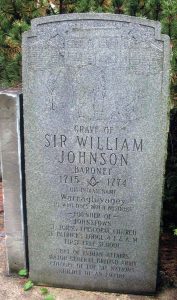 Sir William Johnson was the largest landowner in the area, and husband of Molly Brant. Many Loyalists originally rented property in N.Y. from him.
Sir William Johnson was the largest landowner in the area, and husband of Molly Brant. Many Loyalists originally rented property in N.Y. from him.
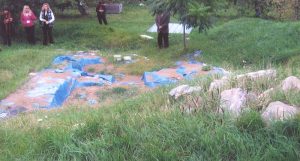 Right: Sir William’s son, Sir John Johnson, was buried in 1830 in Chambly, Quebec, in a family vault. The vault was later hidden by an apple orchard. About 1958 a worker bulldozing a pile of rocks in the orchard found human remains and then re-buried them as he bulldozed the vault into the ground. Now the Société de Restauration du Patrimoine Johnson and the Sir John Johnson Centennial UEL Branch are attempting to restore this tomb as a Loyalist 2014 Project.
Right: Sir William’s son, Sir John Johnson, was buried in 1830 in Chambly, Quebec, in a family vault. The vault was later hidden by an apple orchard. About 1958 a worker bulldozing a pile of rocks in the orchard found human remains and then re-buried them as he bulldozed the vault into the ground. Now the Société de Restauration du Patrimoine Johnson and the Sir John Johnson Centennial UEL Branch are attempting to restore this tomb as a Loyalist 2014 Project.
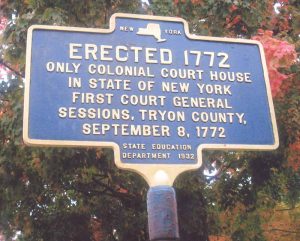 Across the street from Sir William Johnson Park in Johnstown is the Fulton County Court House. Yes, it was built in 1772 for the newly-created Tryon County; but Tryon was later renamed Montgomery County, and then Fulton County was split off from Montgomery. The Court House never moved!
Across the street from Sir William Johnson Park in Johnstown is the Fulton County Court House. Yes, it was built in 1772 for the newly-created Tryon County; but Tryon was later renamed Montgomery County, and then Fulton County was split off from Montgomery. The Court House never moved!
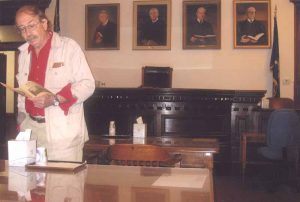 Right: Inside the Court House – which is still in use today.
Right: Inside the Court House – which is still in use today.
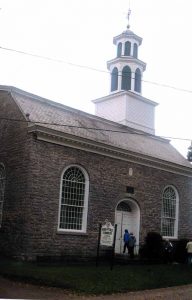 Left: Churches were very important to the early Americans. The Palatine Church near Fort Wagner was erected in 1770 by Palatines, and is preserved by the Palatine Society.
Left: Churches were very important to the early Americans. The Palatine Church near Fort Wagner was erected in 1770 by Palatines, and is preserved by the Palatine Society.
 Right: Another of the few remaining stone churches is the one at Stone Arabia, dating from 1788 – built after the American Revolution, so not familiar to the Loyalists who had by that time fled to Canada – but a lovely building nonetheless.
Right: Another of the few remaining stone churches is the one at Stone Arabia, dating from 1788 – built after the American Revolution, so not familiar to the Loyalists who had by that time fled to Canada – but a lovely building nonetheless.
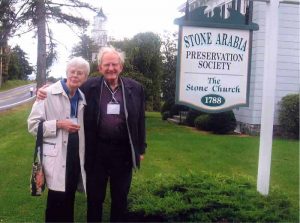
Peter and Carol Davy of Kingston Branch, beside the Stone Church sign.
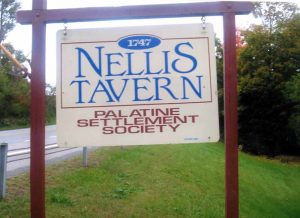 Left: The Palatine Society also look after the Nellis Tavern. The Nellis family were among those who built the Old Palatine Church (above). Members of the family fought on both sides during the Revolutionary War.
Left: The Palatine Society also look after the Nellis Tavern. The Nellis family were among those who built the Old Palatine Church (above). Members of the family fought on both sides during the Revolutionary War.
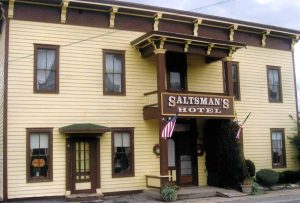 Right:Taverns and inns were major gathering places in their communities — and also provide a good place for hungry tourists to have lunch. The Saltsman’s Hotel in Ephratah, New York was built in 1813.
Right:Taverns and inns were major gathering places in their communities — and also provide a good place for hungry tourists to have lunch. The Saltsman’s Hotel in Ephratah, New York was built in 1813.
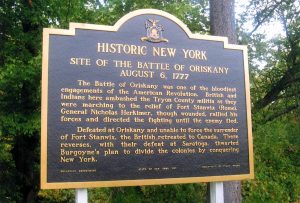 Signs are always erected by the winners. According to Wikipedia, “The battle cost the Patriots approximately 450 casualties [out of 800 men], while the Loyalists and Indians lost approximately 150 dead and wounded [only about 16%].” On the face of it, this would seem to be a Loyalist victory, but Wikipedia adds: “The result of the battle remains ambiguous to this day because the apparent Loyalist victory was tarnished when a party sortied from Fort Stanwix and sacked their camp, spoiling morale among the Indians.” This loss of morale created division among the natives and Loyalists, who had expected support from British regulars, and eventually led to the failure of St. Leger’s expedition and contributed to the British loss at Saratoga.
Signs are always erected by the winners. According to Wikipedia, “The battle cost the Patriots approximately 450 casualties [out of 800 men], while the Loyalists and Indians lost approximately 150 dead and wounded [only about 16%].” On the face of it, this would seem to be a Loyalist victory, but Wikipedia adds: “The result of the battle remains ambiguous to this day because the apparent Loyalist victory was tarnished when a party sortied from Fort Stanwix and sacked their camp, spoiling morale among the Indians.” This loss of morale created division among the natives and Loyalists, who had expected support from British regulars, and eventually led to the failure of St. Leger’s expedition and contributed to the British loss at Saratoga.
Many thanks to Carol and Peter Davy for sharing their photos, and to Ed Kipp for background information.
